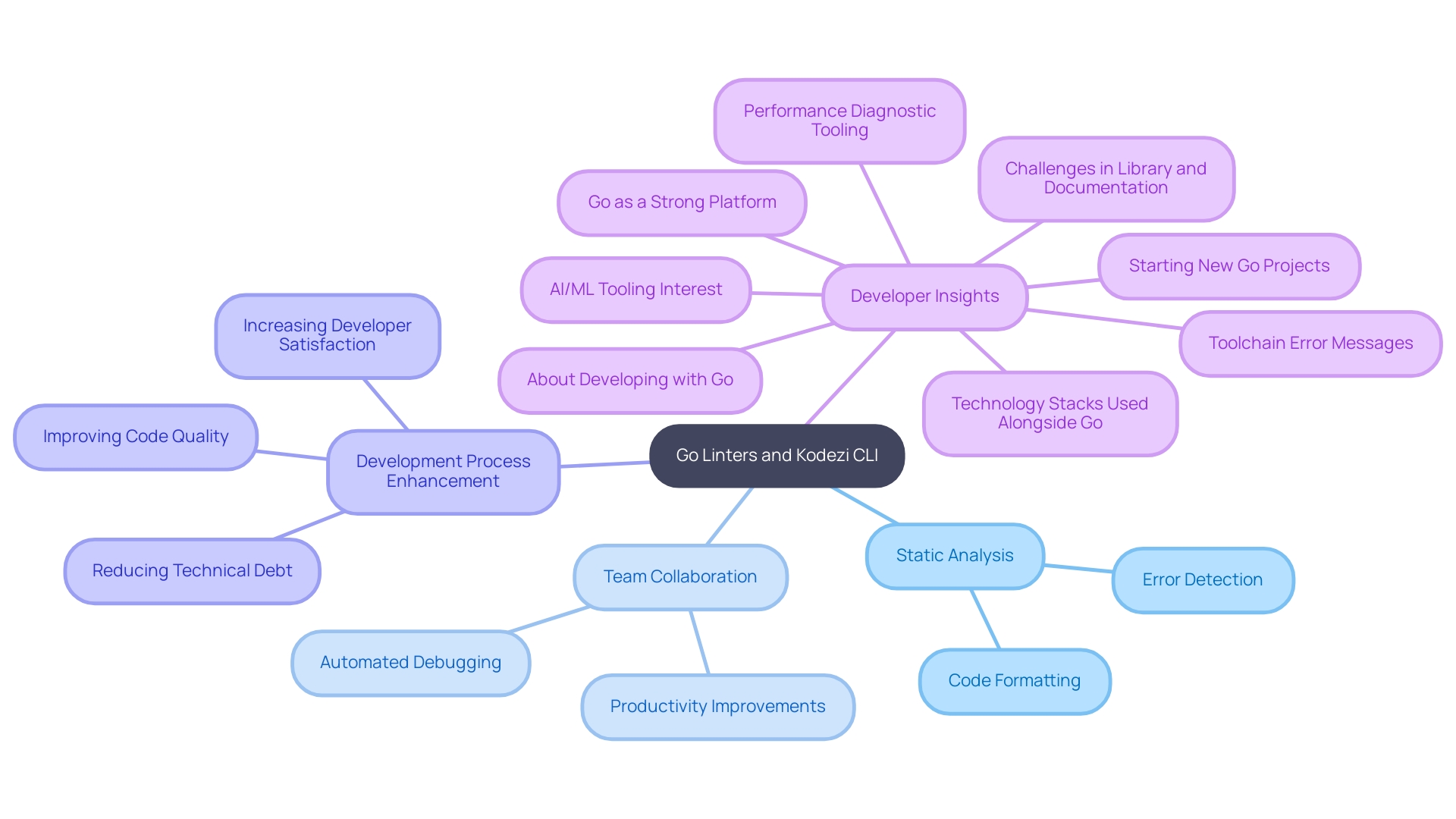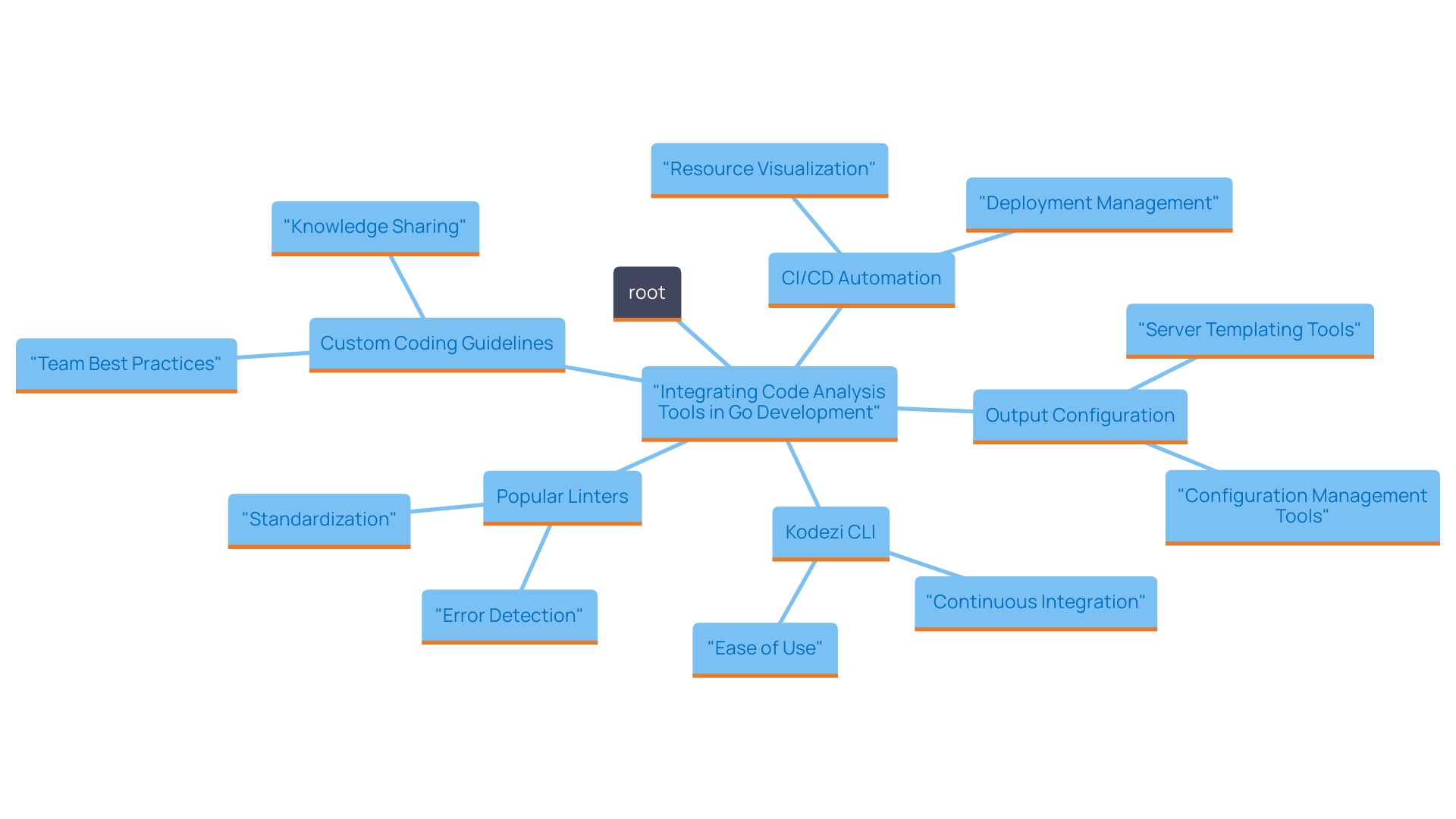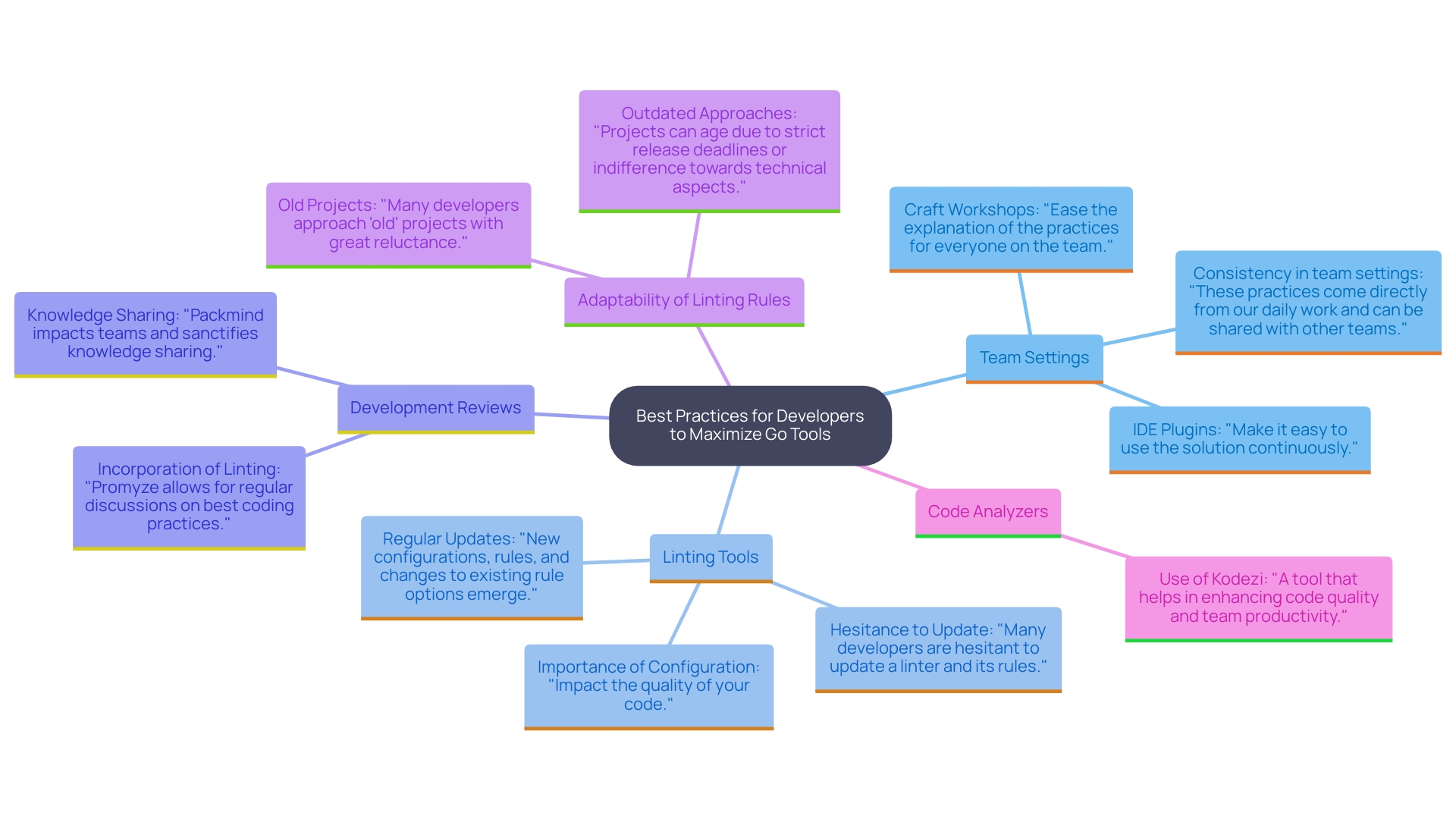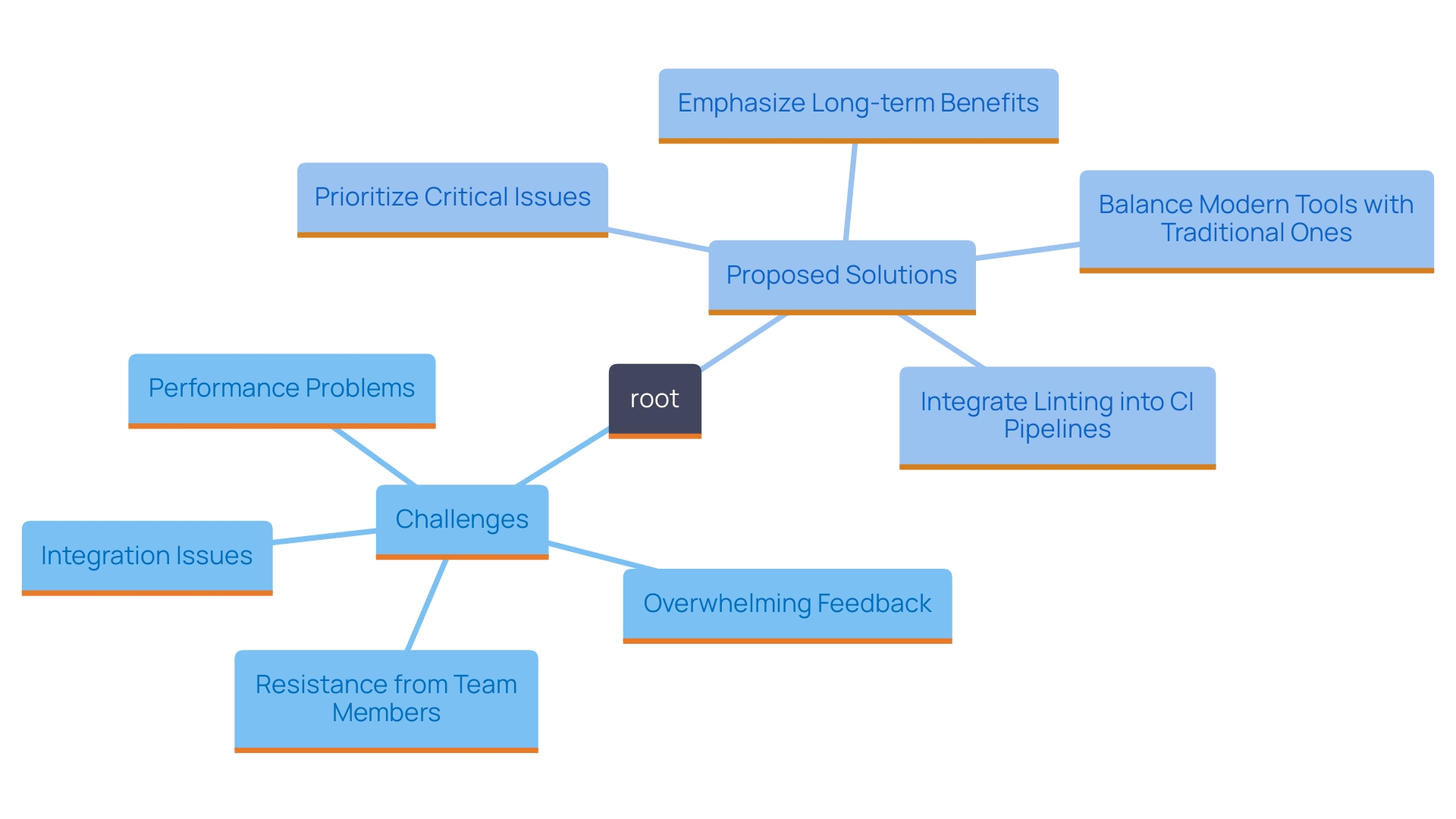Introduction
In the ever-evolving landscape of software development, the pursuit of code quality and efficiency is paramount. Go linters emerge as essential allies in this quest, providing developers with the tools needed to identify potential errors and enforce best practices before code even runs. By integrating these powerful static analysis tools into their workflows, teams can not only enhance collaboration and readability but also significantly reduce technical debt.
With the advent of advanced solutions like Kodezi CLI, the benefits of linting are amplified, enabling rapid debugging and automated fixes that allow developers to focus on innovation rather than mundane tasks. This article delves into the importance of Go linters, effective implementation strategies, best practices, and common challenges, offering insights on how to harness these tools for maximum productivity and improved code quality.
Understanding Go Linters: Definition and Importance
A Go linter is a robust static analysis application created to examine Go source material for possible errors, stylistic concerns, and compliance with programming best practices. These tools are pivotal in preserving software quality by detecting bugs and enforcing programming standards before execution, ensuring that it remains functional, clean, and maintainable. This proactive approach significantly reduces technical debt over time. Research indicates that groups utilizing Go tools experience a significant decrease in code-related problems, showcasing their efficiency in upholding high standards.
By standardizing code formatting and style, Go linters enhance collaboration among team members, making code more readable and understandable. Advanced linting resources also enhance productivity and developer satisfaction, providing contextual education and quick fixes. An advanced linting solution is known to provide extensive libraries of quick fixes and secrets detection across various IDEs, languages, frameworks, and IaC platforms.
Integrating tools like Kodezi CLI can further amplify these benefits. Kodezi CLI excels in automated debugging, rapidly identifying and fixing issues before it is pushed, thereby enhancing performance, ensuring security compliance, and overall enhancement. A case study on improving developer satisfaction revealed that automating the detection of coding issues allows developers to focus on creative tasks rather than mundane bug fixes. This shift results in a more pleasant and efficient development atmosphere while strengthening the advantages of utilizing Go tools, such as enhanced programming quality and developer growth. Kodezi's AI-driven automated builds and testing processes complement the linting procedure, ensuring that quality is consistently enhanced throughout the software development lifecycle. Ultimately, Go code analyzers, alongside tools like Kodezi CLI, are indispensable assets in software development, significantly contributing to both code quality and developer happiness.

How to Write and Implement Go Linters
Integrating Go code analysis tools in your development workflow is essential for maximizing efficiency and maintaining high coding standards. This guide will explore how to effectively integrate Kodezi CLI into your CI/CD pipelines and utilize its features for local development. Start by exploring popular Go linter frameworks like golint and staticcheck. According to recent statistics, over 70% of Go developers utilize code analyzers to enforce consistent coding conventions and best practices across their projects. With the launch of Kodezi CLI in 2023, you can now seamlessly integrate Kodezi into your CI/CD pipelines, enhancing your development process by allowing local feature utilization directly within your workflow.
Next, identify the specific coding guidelines you wish to enforce. This may include creating custom rules tailored to your project's unique requirements. Creating custom Go tools entails developing functions that examine structure and offer practical feedback based on established criteria. Kodezi currently supports over 30 programming languages, allowing for flexible application across various projects.
Once your rules are established, integrate the linter into your development process. This can be done by running the linter manually or automating it within your build system. Utilizing continuous integration (CI) systems, such as GitHub Actions and Travis CI, to run linters on commits ensures that all submissions meet your standards before merging into the main branch. This practice not only maintains quality standards but also streamlines the review process. Kodezi's compatibility with Visual Studio Code (Vs code) further provides an efficient environment for implementing these practices.
As Oleg Kovalov succinctly puts it, 'I prefer the simplest one: line-number and saving to lint.txt.' This approach underscores the importance of clear, accessible output formats, which enhance the usability of linting results for developers. Furthermore, developer Jane Doe highlights the necessity for strong output configuration, stating, 'Readable lint results are crucial for quick fixes and upholding quality.'
A case study on output configuration highlights the benefits of presenting linting results in a readable and user-friendly manner. By adopting these best practices, along with the features offered by Kodezi, groups can achieve a significant boost in productivity and maintain code that is both efficient and easy to manage.

Best Practices for Using Go Linters
To maximize the benefits of Go tools, developers should adhere to several best practices. First, ensure that lines are set up consistently across the team, with all members following the same rules and configurations. Consistency promotes uniformity, reduces confusion, and fosters a collaborative environment. Additionally, regular updates to the linting tools are crucial, as they allow developers to leverage the latest features and improvements.
Incorporating linting into the development process, such as during reviews, helps catch issues early and promotes a culture of quality. As Colin Chartier from the Academy of Code Review Automation Best Practices notes, 'SonarQube for IDE is a free IDE extension to find and fix programming issues in real-time, flagging problems as you create, just like a spell-checker.' This real-time feedback is invaluable for maintaining high code quality and boosting group productivity.
Moreover, groups should be open to modifying linting rules to cater to the specific needs of their projects. For example, a group working on a microservices architecture might need to adjust the rules to accommodate different coding styles and frameworks used across services. Rigid adherence to default rules may not always serve the team's best interests; therefore, tailoring them to address project-specific challenges is essential. Developers should consider code analyzers as resources for learning and development. Kodezi's AI-assisted development resource, which acts as an autocorrect for code, can automatically analyze bugs, correct them, and optimize code, providing contextual guidance that enhances developer skills and promotes best practices.
Statistics indicate that effective use of code analysis tools can reduce debugging time by up to 30%, significantly lowering associated costs. By adhering to these best practices, such as regular updates of resources and adapting linting rules to project requirements, and utilizing Kodezi’s capabilities, groups can ensure they are using Go linters to their fullest potential. This results in more efficient and productive development processes, ultimately leading to higher quality programming and enhanced collaboration among members. Additionally, groups can try Kodezi CLI, a versatile tool designed to auto-heal codebases and enhance programming productivity, offering free trials and demos to get started.

Common Challenges and Solutions with Go Linters
Go linters are invaluable for maintaining quality, yet developers often face significant challenges when incorporating them into their workflows. One prevalent issue is the sheer volume of feedback generated, which can be overwhelming and lead to frustration. To manage this, groups should prioritize critical issues and customize rule sets to minimize unnecessary noise. For instance, a group at Company X established a tiered feedback system, classifying linting issues by severity, which greatly enhanced their efficiency in tackling quality concerns.
Resistance from group members is another common challenge, with some viewing linting as an unnecessary burden. Emphasizing the long-term benefits of improved code quality and maintainability can help overcome this resistance. Highlighting successful case studies, such as those from teams who saw significant improvements in their codebase after implementing code quality tools, can also be persuasive. For instance, Team Y reported a 30% reduction in bugs after adopting a structured linting process, which reinforces the importance of such resources.
Integration issues can further complicate the adoption of Go linters. Ensuring that build processes are properly configured to seamlessly run linting applications is crucial. By addressing these integration challenges proactively, teams can prevent disruptions and maintain a smooth workflow. A practical approach taken by Team Z involved integrating linting into their continuous integration pipeline, which allowed for immediate feedback without disrupting the development process.
Moreover, recognizing that modern development environments, such as Visual Studio, can experience performance issues when overloaded with files highlights the significance of efficient resource management. As one expert aptly stated, 'Don’t go chasing waterfalls, please stick to the Vim and Emacs that you’re accustomed to,' implying that sometimes conventional resources may provide simpler, more efficient solutions. This perspective aligns with the experiences of developers who find that a mix of modern and traditional tools can yield the best results.
Through practical solutions and a strategic approach, developers can effectively embrace Go linters, ultimately fostering a more productive and high-quality coding environment.

Conclusion
Integrating Go linters into the software development process is a game-changer for enhancing code quality and productivity. These powerful static analysis tools not only help identify potential errors and enforce best practices but also foster a collaborative environment by standardizing coding styles across teams. With advancements in tools like Kodezi CLI, developers can automate debugging and implement quick fixes, allowing them to concentrate on creative problem-solving rather than mundane tasks.
Effective implementation strategies, such as customizing linting rules and integrating them into CI/CD pipelines, can significantly streamline workflows. By prioritizing consistency and embracing best practices, teams can maximize the benefits of linting, leading to reduced debugging times and enhanced developer satisfaction. Overcoming common challenges, such as managing feedback volume and addressing resistance to change, is crucial for fully leveraging the potential of Go linters.
In conclusion, the adoption of Go linters, particularly when paired with innovative solutions like Kodezi CLI, is essential for any development team aiming to elevate their code quality and operational efficiency. By embracing these tools and practices, organizations can not only reduce technical debt but also create a more enjoyable and productive development environment, ultimately driving long-term success in their software endeavors.
Frequently Asked Questions
What is a Go linter?
A Go linter is a static analysis tool designed to examine Go source code for potential errors, stylistic issues, and adherence to programming best practices. It helps maintain software quality by detecting bugs and enforcing standards before code execution.
How do Go linters improve software quality?
Go linters enhance software quality by detecting bugs and ensuring compliance with coding standards, which reduces technical debt over time. They also standardize code formatting, improving readability and collaboration among team members.
What benefits do advanced linting resources provide?
Advanced linting resources improve productivity and developer satisfaction by offering contextual education and quick fixes. They come with extensive libraries for quick fixes and secrets detection across various IDEs, languages, and frameworks.
How can Kodezi CLI enhance the use of Go linters?
Kodezi CLI automates debugging and rapidly identifies and fixes issues before code is pushed, enhancing performance and ensuring security compliance. It allows developers to focus more on creative tasks rather than mundane bug fixes, improving the overall development atmosphere.
What are the best practices for integrating Go code analysis tools?
Best practices include establishing consistent coding guidelines across the team, regularly updating linting tools, integrating linting into the development process (e.g., during code reviews), and customizing linting rules to fit project-specific needs.
What challenges do developers face when using Go linters?
Developers often encounter challenges such as overwhelming feedback from linters, resistance from team members, integration difficulties with build processes, and performance issues in modern development environments.
How can teams manage feedback overload from linters?
Teams can manage feedback overload by prioritizing critical issues and customizing rule sets to minimize unnecessary noise. Implementing a tiered feedback system can help classify linting issues by severity.
Why is it important to adapt linting rules for specific projects?
Adapting linting rules is essential to address unique challenges and coding styles specific to different projects, ensuring that the linting process is relevant and beneficial for the development team.
What role does Kodezi's AI-assisted development resource play in coding?
Kodezi's AI-assisted resource acts as an autocorrect for code, automatically analyzing and correcting bugs while providing contextual guidance, which enhances developer skills and promotes best practices.
What impact do Go tools have on developer satisfaction?
The use of Go tools, including linters and Kodezi CLI, significantly contributes to higher code quality and developer happiness by streamlining workflows, reducing debugging time, and fostering a collaborative environment.




